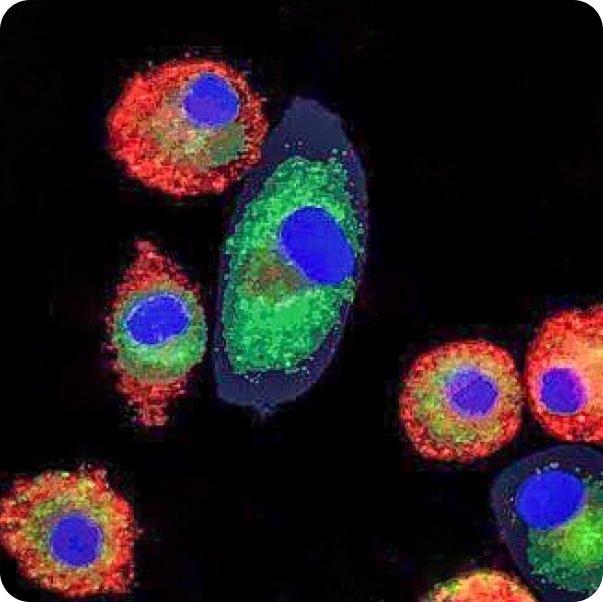
In this piece Cois Coiribe talks to aluma Dr Abigail Martin, CEO and Co-Founder and Director of biotechnology company ImmuONE. Abigail’s love of horses made her interested in how science could help to make animals’ lives better, as well as curious about what we can learn about human health from animal studies. Her company manufactures her innovative product – a human in vitro lung – which has significantly affected how companies test their products, in particular, improving human safety and reducing animal testing. Explore Abigail’s journey below.
Cois Coiribe (CC): Can you take us through your journey, from biotechnology student at University of Galway with a passion for horse-riding, to co-founder of a groundbreaking biotech company?
Abigail Martin: Growing up in Schull, County Cork, Ireland, I had lots of exposure to horses as a teenager. During my transition year in school, I went to England, and trained with some incredible top British horse trainers in the Eventing Industry. Training for Eventing requires developing the horse physically and mentally to the point where the horse performs well. These horses would then be ridden by Olympic riders at the time. I was significantly immersed in the equestrian domain with extensive engagement with horses. When you work with horses in competition, you come across a lot of issues and challenges such as accidents and diseases, which are inherent to their nature.
Biotechnology is a particularly interesting field within sciences. This field allowed us to combine the latest technologies with biology, and it’s seen in areas such as bread- and beer- making all the way through to advanced therapies for treatment of diseases. I’ve always been a problem-solver as well, so in my many years of working with horses, I started to have an interest, not just in their health but also in how we as a society can make animals’ lives better; that is really why biotechnology appealed to me.
In 2007, I embarked on this journey and came to University of Galway to study biotechnology. We covered an array of subjects in my degree including maths, biochemistry, pharmacology, physics and French. Looking back, I think each of these subjects contributed invaluable knowledge that play a pivotal role in my business today.
My degree had a research placement module, and with support from Dr Andrew Flaus at University of Galway, I went to the University of Guelph in Ontario, Canada as a Research Assistant to an incredibly dynamic research group within the Ontario Veterinary College. My work there focused on reproductive toxicology in early pregnancies in horses. Interestingly, the hormonal and general health changes observed in horses during early pregnancy loss are similar to those experienced by humans during pregnancy loss. This further drove me to want to know more about Toxicology and human relevant outcomes from animal studies.
Fast forward a few years I’d gained an MA in Toxicology from University of Galway and a PhD from University of Hertfordshire in respiratory toxicology, had my first patent of a 3D human lung model and a market with a need for it. Sharing similar ethics and the desire to developing animal testing- alternatives that provide more human-relevant results, Prof Victoria Hutter and I founded ImmuONE in 2019.
CC: What did you build/make during your PhD and did you know you were building a commercially viable product?
AM: I knew scientists faced multiple challenges when comparing animal studies to human studies, like reporting scientific data that could then be translated from animal to human was a major issue. For example in the lung, the rat is commonly used to assess the safety of new inhaled medicines except the rat solely breathes through their nose, has anatomically different branching airways and is biologically more sensitive than humans. Hence the need to build a lung system made of human cells to test these new medicines on. As a result of my PhD, I developed a human in vitro model of the lower airways, in short miniature human lungs made up of human cells grown in a dish. The model is made up of different cells representing those found in the deep lung of a human such as barrier cells and immune cells.
Embarking on a PhD can be intense and challenging, especially in the sciences as the failure rate for your experiments are incredibly high. I felt elated as what I created worked. I didn’t realise the research’s true potential until I spoke to the market and met with contract research organisations, big pharma and chemical companies and asked “What would you do with a human lung model?” and their response was “When is it available, we needed it years ago!”
As I travelled the world as part of a UK Government-funded Innovation-to- Commercialisation for University Research (ICURe) initiative, I met with companies, who shared similar feedback and reactions. Armed with this invaluable information, I reported back to ICURe, who awarded us a fund of £300,000 to begin commercialising the technology, build the business and spin out from the university.

CC: Taking a glimpse into the ImmuONE lab for a moment, how does this 3D human lung model operate?
AM: We recently moved to a state-of-the-art facility with 1500 square foot of laboratory space. Working with cells requires maintaining an optimal environment of 37oC, similar to humans. We have special sterile units and controlled workspaces to prevent contamination. Additionally, we have our manufacturing area where we construct the 3D human lung models. As I mentioned, it involves cultivating human cells in a dish. These cells come from the deep lung, specifically the alveolus, where we have barrier cells similar to the epithelial cells on your skin. What makes us truly unique is that the model includes immune cells as well.
Macrophages, which are among the first line of defence cells, play an incredibly important role in the immune response. These cells are particularly tricky to work with. As you can imagine, when you sneeze, it might be due to something as simple as dust, or it could be a response to a more significant irritant, therefore macrophages are integral to distinguishing between these situations or scenarios.
So, we’ve incorporated these cells into a simpler system that allows us to work with various other cell types to build models of diseased lungs or other specific conditions. These models are very small, typically no more than 1 centimetre across in diameter, and are maintained on scaffolds within small wells. We feed these wells, which we call media, ensuring they are sufficiently nourished and kept at specific temperature, which assist in these models growing strong and responsive in the lab.
The 3D human lung models can be grown in multiples, hundreds at a time and can be exposed to various chemicals requiring inhaled safety assessment. Nearly any chemical you inhale legally requires some level of testing. They can be anything from cosmetic powders to household sprays, pesticides, fumes, vapes and new medicines. We test a variety of chemicals for our clients, who are all over the world, on the 3D lung models and measure the biological responses of the cells according to chemical concentration and length of exposure. We then look to see if the chemical in question has caused an adaptive or adverse response to the cells in the model. For example, the size of the cells may change or the cells may show an immune response, die or just do nothing and remain unaffected by the exposure.
CC: How does the lab ensure good standard testing for a range of markets across the globe, and what kind of impact have you seen from your R&D (Research & Development) activity at ImmuONE?
AM: So in terms of facilitating standard testing for global markets, there are different requirements across different continents; however many of them share similar desired outcomes. There are many standards which laboratories will practise, such as good lab practice (GLP). Incorporating GLP allows us to maintain standard processes in the testing of chemicals and manufacture of high- quality lung cell systems.
A couple of the biggest impacts we’ve seen is companies making faster yes/no decisions on new chemicals for products and reduced use of animals for testing. Commercially, for products like cosmetics and other consumer goods, companies want to display the cruelty-free or animal-free testing labels. This is down to heightened consumer awareness of the public. In essence, we assist companies in bringing their products to market faster and safely for human use.
CC: Consumers today are more likely to ask questions about the safety of chemical use in our medicines and products. Have you seen a significant change in industry demands since ImmuONE was founded – particularly after COVID-19?
AM: The short answer is yes, I think COVID-19 really highlighted how little we know about respiratory health, particularly in the deep lung and lower airways.
CC: Is there a specific memory that stands out to you as a pivotal moment in your career? What advice would you give to students in the sciences considering a similar entrepreneurial path?
AM: Maybe not so much of a memory but I’ve always known I want to help and make a difference somewhere! I also enjoy bringing people together and empowering them. The advice I’d offer to students is not to be defined by your exam grades. Not everyone performs incredibly well in exams. It isn’t the only measure of success. Personally, I was a mid-range student, I didn’t achieve a first-class degree. Initially, I let this affect me, then I thought of what I can do to improve myself. I realised I could use this as an opportunity for growth and I returned to pursue a master’s in Toxicology. I found myself more focused and motivated towards my new goals.
Connect with fellow students and avail of all the entrepreneurial supports and resources your university offers. These insights and connections will provide you with valuable insights into running a business.
Finally, it is normal to feel intimidated and uncertain about your knowledge. Remember, you will never learn anything as fast as you have to unless it’s on the spot. Embrace the fact that you won’t know everything at first, especially as you go on your entrepreneurial journey. Build your own network of people that are knowledgeable in the areas that you may not be. They will become your safety net, friends and advisors down the line, giving you confidence and alleviating fears along the way!